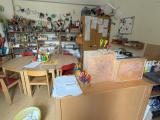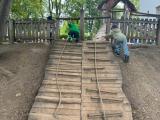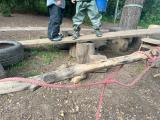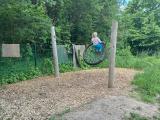News
Early educators’ tour of German Kitas highlights differences from U.S. early childhood programs
This May, TaylorMae Ippolito and Alyssa Wilt, both educators at the Child Development Laboratory School (CDLS), traveled to Germany to learn about Kindertagesstätte, or child care centers, often abbreviated to Kitas. UMN’s Center for European Studies received a grant through the German Academic Exchange Program for a project titled "Kita Lessons for American Preschools," and early childhood educators from all over Minnesota applied to be a part of it. 14 educators joined the two-week journey, which included a week in Berlin and a week in Erfurt, a city with around 200,000 residents. The group toured up to 10 Kitas, including Kitas in the heart of Berlin and Erfurt, Kitas in suburban and rural areas, and even a laboratory school like CDLS which is located at Humboldt University.

Comparing the German and American child care systems
Children share similarities the world over—German preschoolers “pushed the boundaries, which is something you would see anywhere,” observes Ippolito—but the American educators observed a number of differences between Kitas and U.S.-based child care centers. For one thing, many children spend their first year or two at home, because most parents can take paid leave to care for babies. Ippolito and Wilt did not tour any Kitas that served children less than one year old. Children continue to attend Kitas until they start elementary school. That can happen between the ages of five and seven, “depending on what teachers and parents say,” says Anne-Flore Laloë, a working parent whose son started elementary school in Germany this year at age six.
“We’ve had a great experience with the German system,” Laloë says. She and her family live in Heidelberg in the state of Baden-Württemberg. “But I know it’s something that can vary a lot from state to state, though it is mandated at the federal level that every child is entitled to a place from age one.”
Despite this government mandate, the supply of conveniently located care does not always meet demand–a problem that families in the United States can relate to. Hiring sufficient staff can also be an issue, as it is here. The German government continues to pass legislation to address these problems.
Child care in Germany is provided mainly by private non-profit centers. Because this service is publicly subsidized, it is low-cost or even free to families. Most parents, Ippolito and Wilt learned, pay only about $30 a month—often as a stipend for the cost of meals and snacks while their child is in care. The most expensive program that Ippolito and Wilt heard about while in Germany cost $200 per month for a child to attend.
“It was really special to see programs that were university lab schools that were completely free,” says Wilt.
German teachers take a step back so children gain independence
Ippolito and Wilt also took note of differences in the German approach to supervising children and directing their activities.
“One way they foster independence in Kitas is that teachers take a large step back,” says Wilt. “So teachers are not playing with children. They will step in if they see a need, reteach, and then step back again.”
“We saw a lot of positive, child-initiated play,” adds Ippolito. At one Kita they toured, for example, Ippolito remembers that “the children just decided to run through the garden versus the teacher saying, ‘Now we will play tag.’” Teachers might start cooking a meal or gardening, and children could join in if they chose—using real cooking and gardening implements.
“Almost all of the Kitas we toured had wood shops with full-size hammers, saws, everything but drills,” recalls Ippolito. “Sometimes the saws were kept on a higher shelf, sometimes not.”
German licensing requirements also permit a different level of supervision. In a U.S.-based child care center, there must always be an adult within “sight and sound” of every child. That looks a little different in Germany. At the first lab school that the American educators toured, Ippolito noticed that children had access to many different spaces–more spaces than there were teachers. The Kitas used systems like open and closed signs to indicate if children could enter rooms where adults couldn’t see them.
Still, the German educators let children take the lead wherever possible, intervening in their activities only when they judged it truly necessary. For example, at one Kita, Ippolito and Wilt saw children bring a wooden plank over to a big tree stump and try to use it like a seesaw. On this occasion, the German teachers redirected the children away from the stump. But they showed the children a different spot where they could try out their seesaw plan.
“There’s less fear of children getting extremely hurt, because there’s a recognition that a lot of the risks are small,” says Ippolito. “We watched some children climbing a tree, and one of them fell off. She was sad, but ten minutes later, she tried again, and she did it.”
Curriculum is based on children’s interests and needs
Like CDLS, Kitas use a play-based model and what’s known as an emergent curriculum.
“An emergent curriculum means designing learning based off children’s interests and needs,” says Ippolito.
“For example, if a child’s parents think they need to work on sharing, you might selectively choose to not put out enough of a material so that they have to work it out with the other children,” adds Wilt. “Or you might lead a preferred activity in a group where they have to share.”
None of the Kitas that Ippolito and Wilt toured used a prepackaged curriculum.
“Using a pre-written curriculum sounded foreign and novel to the teachers we talked to,” Wilt says.
Most of the Kitas that the group toured had regular assessments, similar to an American child care center or preschool. Kita teachers benchmarked children’s development against the German equivalent of Minnesota’s Early Childhood Indicators of Progress—learning standards that describe what children should know and do by the time they reach kindergarten. However, the educators whom Ippolito and Wilt met did not push children to work on what would be considered school readiness skills in the U.S.
“Reading is not something that’s forced on them in Germany. It’s an option. The science says you can wait till a child is around 8, and they will learn to read in a few months. So their practices in Kitas are very research-based,” Ippolito says. “There are interventions for delays, of course, but their attitude towards children's learning skills is, ‘We’re going to trust that they know when it’s time to do this.’”
Trying out German ideas at home
On their trip, Ippolito and Wilt each found inspiration for ideas they plan to try at CDLS. Wilt, who teaches preschool and also teaches college courses in early childhood education, is intrigued by a common German practice of putting away toys for a period of a few weeks when children are preschool age. When toys are put away, children find creative ways to play with other objects and materials in their environment. CDLS emphasizes outdoor learning, and educators there—children, too—will tell you that natural materials like mud, pinecones, and sticks are great fun to play with.
Ippolito, who teaches toddlers, is in the process of creating a woodshop with tools, wood, and glue that children can work with outdoors. Ippolito and their co-teacher have also designated an art space in their classroom where materials are freely accessible to the children. Children can choose to paint and draw at any time, rather than waiting for an adult to bring out the art supplies.
The fact that Kitas de-emphasize academics—instead favoring play-based learning and child-led exploration—also resonated with Ippolito and Wilt. Wilt reflected that “in general, parents [in the U.S.] might like to know they can relax a little bit [when it comes to Kindergarten readiness]. Your child is going to gain the skills that they need to be successful.”
“‘Kindergarten readiness’ has become a cultural norm,” Ippolito agrees. “It’s not that we’re saying you should ignore academics, but we should also not force them onto children when they’re not ready. Kitas create great functioning members of society.”















